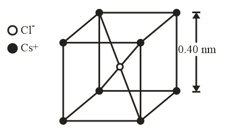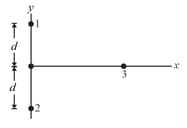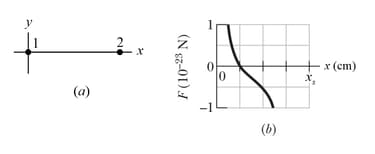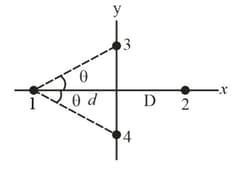In crystals of the salt cesium chloride. cesium ions form the eight corners of a cube and a chlorine ion is at the cube's center. The edge length of the cube is . ions are each deficient by one electron (thus each has a charge ), and the ion has one excess electron (thus has a charge ).
What is the magnitude of the net electrostatic force exerted on the ion by the eight ions at the corners of the cube?
If one of the ions is missing, the crystal is said to have a defect. What is the magnitude of the net electrostatic force exerted on the ion by the seven remaining ions?


Important Questions on Coulomb's Law
Two particles are fixed on axis. Particle of charge is located at , particle of charge is located at and particle of charge magnitude is released from rest on the axis at . What is the value of , if the initial acceleration of particle is in the positive direction of the
axis
axis
Calculate the number of coulombs of positive charge in of (neutral) water.
(A hydrogen atom contains one proton and an oxygen atom contains eight protons.)
Electrons and positrons are produced by the nuclear transformations of protons and neutrons, respectively. The process is termed as beta decay.
If a proton transforms to a neutron, then is an electron or a positron produced?
If a neutron transforms to a proton, then is an electron or a positron produced?
Particles and of charge are on -axis at distance from the origin. Particle of charge is moved gradually along the -axis from to . At what values of , will the magnitude of the electrostatic force on the third particle from the other two particles be
minimum?
maximum?
What is the
minimum magnitude?
maximum magnitude?

In the figure, particle (of charge ) and particle (of charge ) are fixed in place, on the -axis, apart. Particle of charge ) is to be placed on the line between particles and , so that they produce a net electrostatic force on it. Figure gives the -component of that force versus the coordinate , at which particle is placed. The scale of the -axis is set by . What are the sign of charge and the ratio ?

A particle of charge is separated by from a particle of charge .
What is the magnitude of the electrostatic force between them? What must their separation be reduced that force is of an order of magnitude ?
The figure shows an arrangement of four charged particles, with angle and distance . Particle has charge , particles and have charges .
What is distance between the origin and particle if the net electrostatic force on particle due to the other particles is zero?
If particles and were moved closer to the -axis but maintained their symmetry about that axis, would the required value of be greater than, less than, or the same as in part ?

In the given figure, three charged particles lie on an -axis. Particles and are fixed in place. Particle is free to move, but the net electrostatic force on it from particles and happens to be zero. If what is the ratio ?

